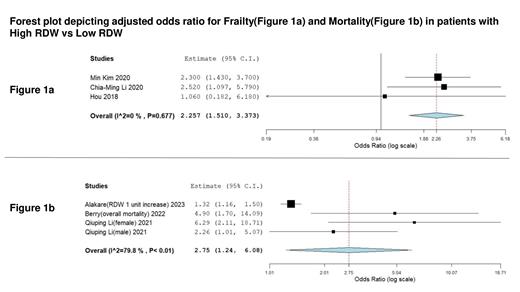Introduction
Red cell distribution width(RDW) is a measure of variation in red blood cell size. Although not very sensitive or specific to diagnose anemia, RDW is identified as a marker of inflammation and oxidative stress. Multiple studies in recent times have evaluated its association with overall mortality, frailty, venous thromboembolism, chronic kidney disease, and liver disease. Identifying frailty and risk of mortality is crucial and may help curtail adverse health outcomes in the aging population. We conducted a systematic review and meta-analysis to identify if high RDW serves as an indicator of frailty and mortality.
Methods
We performed a comprehensive review of Pubmed, Scopus, and Google Scholar until June 2023 using appropriate keywords to identify studies evaluating the risk of frailty and mortality in patients with high RDW. Binary random-effects model was used to estimate pooled odds ratios (OR) and 95% confidence intervals (CI). Leave one out sensitivity analysis was performed. Heterogeneity was assessed using I2 statistics. A p<0.05 was considered statistically significant.
Results
A total of 9 studies were included with data spreading across 9 countries. Sample size included 881 and 1180 individuals with high RDW that reported frailty and mortality as an outcome respectively, and 5919 and 4426 individuals with normal RDW that reported frailty and mortality as an outcome respectively. Unadjusted odds for frailty were 2.10 (95% CI, 1.78 - 2.47; p-value < 0.01) with heterogeneity of 0%(I2) whereas adjusted odds were 2.257 (95% CI, 1.510 - 3.373; p-value < 0.001) and heterogeneity of 0%(I2). Similarly, unadjusted odds for mortality were 3.30 (95% CI, 2.21- 4.94; p-value < 0.01) with heterogeneity of 75.16%(I2) and adjusted odds for mortality were 2.75 (95% CI, 1.24 - 6.08; p-value 0.01) with heterogeneity of 79.8%(I2). Sensitivity analysis using leave one out method demonstrated similar results.
Conclusion
This study concludes that there is a significantly higher risk of frailty (125%) and mortality (175%) in individuals with high RDW. RDW is a readily available and a cost effective tool. Consequently, there is a need for additional research to investigate the potential of RDW as a predictor for morbidity and mortality in various settings, such as patients undergoing targeted interventions, pre-procedural assessments, and in specific disease populations.
Disclosures
No relevant conflicts of interest to declare.


This feature is available to Subscribers Only
Sign In or Create an Account Close Modal